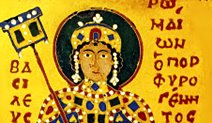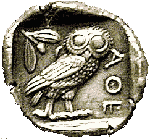Julian the Apostate(361-363)
Julian was the last Roman non-Christian emperor. He rejected Christianity in favor of Neoplatonic paganism. For this reason, he has been vilified by most Christian sources, beginning with John Chrysostom and Gregory Nazianzus in the later 4th century and acquired the epithet "Apostate". Although this is a Greek word, in Greek, his preferred epithet is "Paravates" meaning "violator". |
Leo I the Thracian(457-474)
The name of Leo I before becoming an emperor was Marcellus. After a revolt in Thrace in 470, it was revealed that the rebellion was encouraged by Ardabur the son of the powerful Alan Aspar. Leo realized that Aspar was a serious threat. Aspar and Ardabur were murdered in the palace, in 471, by eunuchs. Leo had a taste for Greek names: He chose "Leo", an uncommon Greek name, for himself, "Ariadne" for his doughter and "Zeno" for his son-in-law. |
Zeno(474-475 & 476-491)
Zeno came from Isauria, a region around Taurus mountains in Asia Minor, and his real name was “Tarasicodissa”. He became general of the army and he took the emphatically Greek name “Zeno” when he married Leo I’s daughter. The people hated him because he was not coming from the Greek-Roman elite. |
Anastasius I(491-518)
Anastasius was nicknamed "Dicorus" (Greek: Δίκορος, "two-pupils"), because his eyes had different colors: one black, one blue. |
Constans II(641-668)
Constans II had been baptized Heraklios and reigned officially as Constantine. "Constans" is a diminutive nickname established itself in Byzantine texts and in historiography. In fact, he was referred as Constantine Pogonatos and not Constans Pogonatos. All this name-dropping is confusing and probably that is why until the 1990s, historians believed that his son, Constantine IV, was the "Pogonatos". Today it is known that Constans II was the real Pogonatos. |
Justinian II Rhinotmetos(685-695 & 705-711)
The sobriquet "Rhinotmetos" means "cut nose." Justinian II’s nose was cut off when he was dethroned. It was believed then, that a disfigured man could not serve as emperor. However, after an adventure-filled interregnum, Justinian regained the throne and reigned for six years without a nose. After this, rhinokopia was never used again. |
Constantine V Kopronymos(741-775)
Constantine V had the worst epithet: "Kopronymos" which means "Dung-named", from kopros ("feces" or "manure") and onoma ("name"). Constantine was the champion of Iconoclasm, a movement that divided the empire for decades. For this reason, chroniclers and church writers were furious against him. Using this obscene name, they spread the rumor that, as an infant, he had defecated in his baptismal font, or the imperial purple cloth with which he was swaddled. This event was taken as a sign of his future evil by the patriarch Germanus. |
Constantine VI the Blind(780-797)
Constantine VI had the epithet "the Blind" because he was blinded after his dethronement. Two things must have made the case of Constantine VI exceptional and earned for him the "Blind" title: a) he was the first emperor who was blinded, b) he was blinded on the orders of his mother, Irene... |
Nikephoros I Logothetes(802-811)
Nikephoros had the epithets "Logothetes" or "Genikos". The reason: he was sort of a finance minister (logothetēs tou genikou) before becoming an emperor. |
Michael II the Stammerer(820-829)
Despite his nickname, Michael II was not stammering, probably. |
Michael III the Drunkard(842-867)
Michael III was given the disparaging moniker "the Drunkard" (Μέθυσος) by the hostile historians of the succeeding Macedonian dynasty. He was described as a vicious, brutal and violent ruler, a pleasure-seeker and -well- a drunkard. Modern historical research has largely rehabilitated him, demonstrating the vital role his reign played in the resurgence of Byzantine power in the 9th century. Maybe Michael was a pleasure-seeker (most emperors were) but, presumably, contemporary historians wanted to provide an excuse for the murder of Michael by Basil I, the founder of the excellent Macedonian dynasty. |
Constantine VII Porphyrogenetos(913-959)
The strange epithet of Constantine VII "Porphyrogenetos", meaning the "Purple-born" alludes to the Purple Room of the imperial palace, decorated with porphyry, where legitimate children of reigning emperors were normally born. Constantine was also born in this room, although his mother Zoe had not been married to his father Leo VI at that time. Nevertheless, the epithet allowed him to underline his position as the legitimized son, as opposed to all others who claimed the throne during his lifetime. Sons born to a reigning Emperor held precedence in the Byzantine line of succession over elder sons not born "in the purple". |
Nikephoros II Phocas(963-969)
"Nomen ist omen". Nikephoros Phokas was one of the most victorious Byzantine emperors and his name "Nikephoros" means "the Victory bearer". |
Michael V the Caulker(1041-1042)
The father of Michael V the "Caulker" or "Kalaphates" (Καλαφάτης) was a caulker who later, with the support of his brother, the eunuch Ioannes Oprhanotrofos, became an admiral of the Byzantine fleet (the father). When Michael tried to banish the popular empress -and his stepmother- Zoe, the people of Constantinople revolted. Their motto was "We do not want the caulker, we want our mother Zoe". After this episode, Michael was dethroned, blinded, castrated and got himself a nickname. (Note: Traditional caulking on wooden vessels used oakum [hemp fiber soaked in pine tar] applied on the wedge-shaped seams between the planks.) |
Constantine IX Monomachos(1042-1055)
The official epithet of Constantine IX, “Monomachos”, was not a nickname. It was just his family name before becoming an emperor. “Monomachos” in Greek means "one who is fighting alone". It is also the Greek translation for “gladiator”. There was another king with the same epithet: the Russian Tsar Vladimir Monomach who was his grand son, son of his daughter Anastasia by his first wife Scleraina (who was the aunt of his mistress Maria Scleraina). |
Michael VII Doukas(1067-1068 & 1071-1078)
Michael VII Doukas, the impotent successor of Romanos Diogenes, was nicknamed Parapinakis (Παραπινάκης) which roughly means “minus a quarter”. The reason was the devaluation of the currency as a result of the financial collapse of the empire in his days. |
John II Komnenos(1118-1143)
The Latin historian William of Tyre described Ioannis II Komennos as short and unusually ugly, with eyes, hair and complexion so dark that he was known as “the Moor”. Yet, despite his physical appearance, John was known as Kaloïoannis (Καλοϊωάννης) or "John the Handsome". It is possible that the epithet was referring to the kindness of his soul, but it is almost certain that it was an euphemism or a mockery for his physical appearance. |
Alexios III Angelos(1195-1203)
Alexios III Angelos was one of the worst Byzantine emperors. He ascended to the throne after dethroning and blinding his brother Isaac Angelos who had saved him from exile. As a ruler, Alexios used the name Alexios Komnenos, obviously in an effort to fake a relation with the glorious Komnenid dynasty and perhaps to make people forget the family ties with the emperor he had mutilated. |
Alexios V Doukas Murtzuphlos(1204)
Alexios V Doukas remained in history with the peculiar nickname "Murtzuphlos". |
Constantine XI Palaiologos(1449-1453)
The last Byzantine emperor is sometimes mentioned as Constantine Dragases. The surname was the Greek version of "Dragas", the family name of Constantine’s Serbian mother. Constantine had adopted the surname and used it before becoming emperor. |
Stories about the Byzantine Emperors

Byzantine Chronicle

Names, Nicknames & Epithets of the Emperors
























